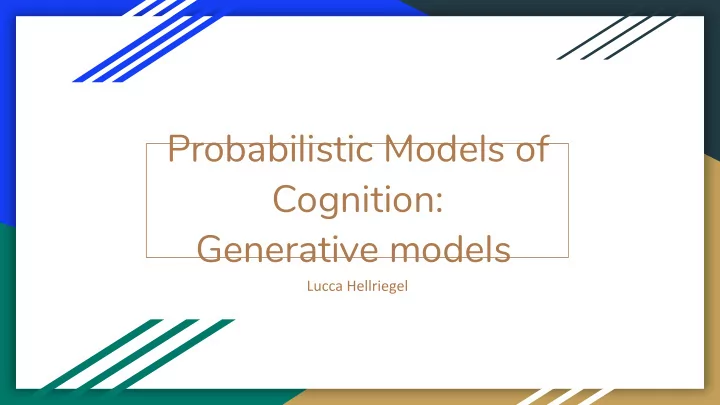

Probabilistic Models of Cognition: Generative models
Table of Contents ● ● ●
Chapter Content
Generative Model
Example: Plinko Machine
Working Model can be used captures some for simulation structure of the world in useful way
Plinko Machine Demo ● Simulate outcomes (data) many times, shape emerges ● Reason about ‘shape of expected outcomes’ (with probabilistic concepts) ● How to formally describe simulations/working models?
Building Generative Models …
Examples with Flip
Flip ● ●
Flip Sum ● ○ ●
Flipping Coins Bend ●
Flipping Coins Bend ● var bend = function(coin) { return function() { (coin() == 'h') ? makeCoin(0.7)() : makeCoin(0.1)() } }
Flipping Coins Bend ● ● ● ●
Flipping Coins Repeat Sum ● ● ● ● ●
Causal Models in Medical Diagnosis ● ● ● ●
Advanced Causal Models in Medical Diagnosis ● ● ●
Probability Concepts and WebPPL
Probability ● ● ●
Probability Distribution ● ● ● ●
Distributions in WebPPL ● ● ● ●
Distributions in WebPPL ● ● ● ●
Constructing marginal distributions: Infer ● ● ● ● ●
Constructing marginal distributions: Infer ● ● ○ ○
● ●
The Rules of Probability
Product Rule ● ● ● ● ● ○
Product Rule ● ● ● ●
Product Rule ● ● ● ● ●
Product Rule ● ● ● ●
Product Rule ● ○ ∣ ○ ● ∣
Product Rule ● ● ● ● ●
Sum Rule ● ● ● ●
Sum Rule ● ○ ○ ○
Sum Rule ● ● ● ●
Sum Rule and Product Rule ●
Sum Rule and Product Rule ● ●
Sum Rule and Product Rule ● ●
Advanced WebPPL
Stochastic recursion ● ● ●
Persistent Randomness: mem ● ● ● ●
Persistent Randomness: mem ● ● ●
Persistent Randomness: mem ●
Persistent Randomness: mem ● ● ● ● ●
Example: Intuitive physics
Example: Intuitive physics ● ●
Example: Intuitive physics ● ●
Example: Intuitive physics ●
Example: Intuitive physics ● ○ ○ ○ ○
Summary of Chapter Content ● ● ● ● ● ○ ● ○ ● ○
Exercises
Exercise 1 a) ● ● ○ ○ ● ○ ○
Exercise 1 a) ● ● ○ ○ ● ○
Exercise 1 a) ●
Exercise 1 b) ● ● ●
Exercise 1 c) ●
Exercise 1 c) ● ○
Exercise 1 c) ● ○ ○
Exercise 1 c) ● ○ ○ ● ○ ○
Exercise 2 Just one execution of flip
Exercise 2 b) ●
Exercise 2 c) ● ●
Exercise 3
Exercise 3 a) ● ● ● ●
Exercise 3 b) ● ● ● ● ● ● ●
Exercise 4 a) ● ● ●
Exercise 4 b) ●
Exercise 4 c) ● ●
Exercise 4 c) ● ● ●
Exercise 5 ● ● ○
Exercise 5 a) ● ● ○
Exercise 5 a) ● ○
Exercise 6 a) ● ○
Exercise 6 b) ● ○
Exercise 7 a) ● ●
Exercise 7 b) ●
Exercise 8 a) ● ○ ○ ○ ■
Exercise 8 b) ●
Recommend
More recommend